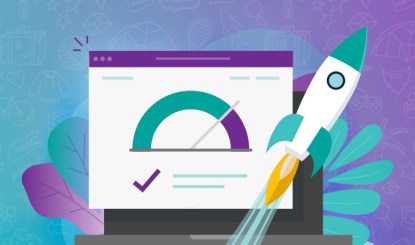4 simple ways to make your website faster (and rank higher)
Websites take constant maintenance and review to ensure your site is optimized and easily found. It’s easy to forget page speed and accessibility with all the other tasks on your plate. These four simple tips are a quick way to make your website faster.
Use Great Hosting
Hosting services are critically important to the speed and performance of your website. Think about it: your host stores all the files of your website and serves them to website visitors. You may have taken the time to make sure your content is optimized, but unless it’s being served by a great host, all of that work is for nothing.
Do your homework and shop the market. Find a host that has competitive pricing and can offer competitive and outstanding performance. Avoid shared hosting and be careful about inexpensive service. If it sounds too good to be true, it probably is.
We’ve helped many of our clients navigate this process, and here are some of our top picks for hosting:
Whether you’re switching to a new hosting service with an existing website, or you’re starting a new website with a hosting service, use Google Analytics and Google Search Console to monitor performance. These tools will tell you if there’s a problem with your content.
Stay Up-to-date
No matter what content management system (CMS) you’re using, you should make sure your platform is up-to-date. Completing regular updates makes sure your site is performing at an optimal level. Using outdated software means you’re not getting the most out of that software, and that can sometimes mean impacted website performance.
Some platforms even let you turn on automatic updates internally, or, if you’re using a great hosting service, some might offer managed hosting, which may include automatic updates to the CMS. If you’re not able to turn on automatic updates, your organization should schedule time at least once a month to check for core updates to the CMS, as well as add-ons, or plugins, depending on the CMS you’re using. This is a great best practice that can help you deliver an optimal experience to website visitors.
Optimize Images
If you’re building a new website, it’s a great idea to start building content with best practices in mind. This means scaling and compressing images as much as possible, to optimize page load times. When building new pages on a new site, you may even want to use PageSpeed Insights, to test pages after they launch and see if there are additional image recommendations made by the tool. You should also monitor performance using Google Search Console, or Bing Webmaster Tools, respectively.
If you have established content on your site that leverages unoptimized images, it’s time to roll up your sleeves and get to work. Many websites today are using a CMS, to organize, optimize, and manage content on their website. If you’re using a CMS, there’s a good chance there’s solution that can optimize your images in bulk. Some CMS options offer a free solution, while others may offer premium options. Either way, you should seriously consider optimizing images on sites that are well established, in order to bring load times down across the entire site. Improving performance this way can help your brand deliver a better experience to users.
Wrap-up
In today’s web, performance is important. If you’re concerned about delivering a fast user experience (and you should be), make sure you’re using top-notch hosting, keeping your CMS up-to-date, and optimizing images across the site. These actions can lay a great foundation for speed and performance, but there’s also more we can help you accomplish and deliver a great website experience to your customers and website visitors. If you need help making your site fly, reach out to the team here at Hammer Marketing. We’re well experienced with many of the top-market CMS platforms in the market and know how to help organizations improve the performance of their website. Contact us to start a project today!
